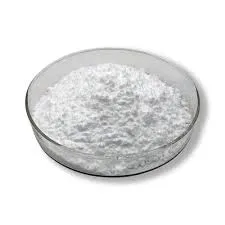
11-р сар . 04, 2024 15:26 Back to list
Understanding Hydroxyethyl Cellulose Properties and Applications in Various Industries
Understanding Hydroxyethyl Cellulose CAS No. 9004-62-0
Hydroxyethyl cellulose (HEC) is a non-ionic, water-soluble polymer derived from cellulose, a natural polymer found in the cell walls of plants. With the Chemical Abstracts Service (CAS) number 9004-62-0, HEC is widely used in various industries due to its unique chemical properties and multifunctional attributes.
Structure and Properties
HEC is synthesized by the etherification of cellulose with ethylene oxide. The introduction of hydroxyethyl groups into the cellulose backbone enhances its solubility in water and allows it to form viscous solutions. This property makes HEC an excellent thickening agent, binder, and stabilizer in formulations. The degree of substitution, which indicates the number of hydroxyethyl groups replaced on the cellulose molecule, influences its properties such as viscosity and solubility.
One of the notable characteristics of HEC is its ability to form gels and provide a smooth texture in various applications. Additionally, it is characterized by its stability across a range of pH levels and temperatures, which extends its usability in diverse environments.
Applications in Different Industries
HEC is widely used in pharmaceuticals as an excipient, where it acts as a binder, thickener, and film-forming agent. It is often found in ointments, creams, and gels, providing a controlled release of active ingredients. Due to its biocompatibility and non-toxic nature, HEC is suitable for various medical applications, including drug delivery systems.
2. Cosmetics and Personal Care
In cosmetics, HEC contributes to the texture and stability of products such as lotions, shampoos, and conditioners. It enhances the spreadability and provides a silky feel on the skin and hair. Moreover, HEC is utilized in formulations requiring viscosity adjustments, contributing to a luxurious sensory experience.
hydroxyethyl cellulose cas no

3. Food Industry
HEC is also employed in the food industry as a food additive and thickening agent. It is capable of providing stability to emulsions, preventing separation and improving texture. HEC is recognized for its low-calorie properties, making it an appealing choice for low-fat and low-calorie food products.
4. Construction and Coatings
In construction, HEC is used in cement, gypsum, and other building materials to enhance workability and prevent segregation. It acts as an adhesive and improves the performance of these materials. Furthermore, in the coatings industry, HEC is valued for its ability to provide excellent viscosity and flow properties, making it an ideal ingredient in paints, adhesives, and sealants.
5. Agriculture
HEC finds applications in agriculture in the formulation of pesticides and herbicides, where it serves as a thickener and stabilizer. Its ability to enhance the retention of active ingredients in formulations improves the effectiveness of agricultural products.
Environmental and Safety Considerations
As a derivative of cellulose, HEC is biodegradable and presents minimal environmental risks compared to synthetic polymers. It has a favorable safety profile, as it is non-toxic and non-irritating when used in recommended applications. Regulatory agencies, such as the Environmental Protection Agency (EPA), have classified HEC as safe for use in various products, contributing to its increasing adoption across multiple sectors.
Conclusion
Hydroxyethyl cellulose (CAS No. 9004-62-0) is a versatile and valuable polymer with significant contributions across numerous industries. Its unique properties, including water solubility, viscosity control, and biocompatibility, make it an essential ingredient in pharmaceuticals, cosmetics, food products, construction materials, and more. As industries continue to advance towards more sustainable practices, the demand for biocompatible and environmentally friendly agents like HEC is likely to grow, paving the way for further innovations and applications. Understanding HEC and its applications can provide valuable insights for professionals in related fields, promoting the efficient use of this functional polymer in various formulations.
-
What is HPMC?
NewsJun.06,2025
-
Understanding Redispersible Powder: The Future of Construction Materials
NewsJun.06,2025
-
Understanding RDP Powder: The Ultimate Solution for Your Construction Needs
NewsJun.06,2025
-
Pure HPMC: The Ideal Solution for Modern Construction and Building Materials
NewsJun.06,2025
-
Methyl Hydroxyethyl Cellulose: A Versatile Chemical Compound
NewsJun.06,2025
-
Hydroxyethyl Cellulose Power: The Essential Chemical for Various Industries
NewsJun.06,2025







